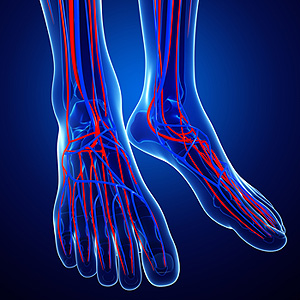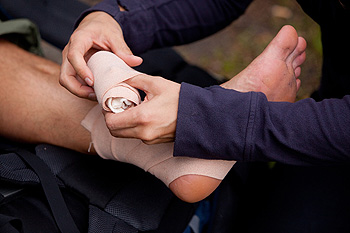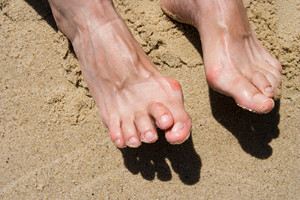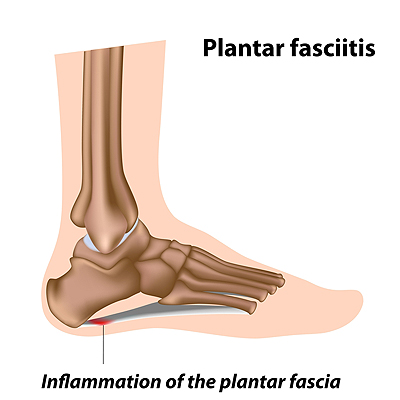Dr. Kennan T. Runte, DPM, FACFAS
Dr. Panah Nabili, DPM
Grass Valley, CA 95945
Dr. Kennan T. Runte, DPM, FACFAS
Dr. Panah Nabili, DPM
 Chronic venous insufficiency is a condition in which veins do not work properly and have a reduced capacity to transport blood throughout the body and back to the heart. Symptoms of chronic venous insufficiency frequently show in the legs and feet. You may experience heaviness, throbbing, or dull aches in the legs, swelling in the legs and ankles, cramping, changes in skin color or texture, and open sores, blood clots, and varicose veins in the legs. There are a variety of treatments available for this condition, including medications and both surgical and nonsurgical procedures. For more information about chronic venous insufficiency, please consult with a podiatrist.
Chronic venous insufficiency is a condition in which veins do not work properly and have a reduced capacity to transport blood throughout the body and back to the heart. Symptoms of chronic venous insufficiency frequently show in the legs and feet. You may experience heaviness, throbbing, or dull aches in the legs, swelling in the legs and ankles, cramping, changes in skin color or texture, and open sores, blood clots, and varicose veins in the legs. There are a variety of treatments available for this condition, including medications and both surgical and nonsurgical procedures. For more information about chronic venous insufficiency, please consult with a podiatrist.
Poor circulation is a serious condition and needs immediate medical attention. If you have any concerns with poor circulation in your feet contact one of our podiatrists of Foothill Podiatry Clinic. Our doctors will treat your foot and ankle needs.
Poor Circulation in the Feet
Poor blood circulation in the feet and legs is can be caused by peripheral artery disease (PAD), which is the result of a buildup of plaque in the arteries.
Plaque buildup or atherosclerosis results from excess calcium and cholesterol in the bloodstream. This can restrict the amount of blood which can flow through the arteries. Poor blood circulation in the feet and legs are sometimes caused by inflammation in the blood vessels, known as vasculitis.
Causes
Lack of oxygen and oxygen from poor blood circulation restricts muscle growth and development. It can also cause:
Those who have diabetes or smoke are at greatest risk for poor circulation, as are those who are over 50. If you have poor circulation in the feet and legs it may be caused by PAD and is important to make changes to your lifestyle in order to reduce risk of getting a heart attack or stroke. Exercise and maintaining a healthy lifestyle will dramatically improve conditions.
As always, see a podiatrist as he or she will assist in finding a regimen that suits you. A podiatrist can also prescribe you any needed medication.
If you have any questions please feel free to contact our office located in Grass Valley, CA . We offer the newest diagnostic and treatment technologies for all your foot and ankle needs.
 Ankle sprains occur when the ligaments that connect the bones in the ankle become stretched or torn. Ankle sprains are divided into 3 categories. A Grade 1 sprain occurs when the ligament is mildly stretched. Once a ligament is slightly torn, a Grade 2 sprain occurs. A Grade 3 ankle sprain is the complete tear of one of the ligaments in the ankle. Sprains are usually indicated by pain, tenderness, bruising, stiffness, and an inability to put weight on the affected ankle. Upon experiencing a possible ankle sprain, it is important to visit with a podiatrist. A podiatrist will take X-rays to make sure there isn’t a fracture, and they will also determine the severity of the sprain. After the injury is assessed, your podiatrist will suggest the proper treatment options.
Ankle sprains occur when the ligaments that connect the bones in the ankle become stretched or torn. Ankle sprains are divided into 3 categories. A Grade 1 sprain occurs when the ligament is mildly stretched. Once a ligament is slightly torn, a Grade 2 sprain occurs. A Grade 3 ankle sprain is the complete tear of one of the ligaments in the ankle. Sprains are usually indicated by pain, tenderness, bruising, stiffness, and an inability to put weight on the affected ankle. Upon experiencing a possible ankle sprain, it is important to visit with a podiatrist. A podiatrist will take X-rays to make sure there isn’t a fracture, and they will also determine the severity of the sprain. After the injury is assessed, your podiatrist will suggest the proper treatment options.
Ankle sprains are common but need immediate attention. If you need your feet checked, contact one of our podiatrists from Foothill Podiatry Clinic. Our doctors can provide the care you need to keep you pain-free and on your feet.
How Does an Ankle Sprain Occur?
Ankle sprains take place when the ligaments in your ankle are torn or stretched beyond their limits. There are multiple ways that the ankle can become injured, including twisting or rolling over onto your ankle, putting undue stress on it, or causing trauma to the ankle itself.
What Are the Symptoms?
Preventing a Sprain
Treatment of a Sprain
Treatment of a sprain depends on the severity. Many times, people are told to rest and remain off their feet completely, while others are given an air cast. If the sprain is very severe, surgery may be required.
If you have suffered an ankle sprain previously, you may want to consider additional support such as a brace and regular exercises to strengthen the ankle.
If you have any questions please feel free to contact our office located in Grass Valley, CA . We offer the newest diagnostic and treatment technologies for all your foot and ankle needs.
 A hammertoe is one of the most common toe deformities in which one or more of the little toes bends abnormally at the middle joint, giving the toe a hammer-like appearance. It can be caused by wearing poorly fitted shoes, nerve damage to the foot, rheumatoid arthritis, and trauma to the toes. The symptoms of hammertoe often include difficulty moving the affected toe, pain, and the formation of corns and calluses on top of the affected toe as it rubs repeatedly against your shoes. There are a variety of both conservative and surgical treatments that your podiatrist may recommend depending on the severity of your hammertoe. To learn more about this condition, please consult with a podiatrist.
A hammertoe is one of the most common toe deformities in which one or more of the little toes bends abnormally at the middle joint, giving the toe a hammer-like appearance. It can be caused by wearing poorly fitted shoes, nerve damage to the foot, rheumatoid arthritis, and trauma to the toes. The symptoms of hammertoe often include difficulty moving the affected toe, pain, and the formation of corns and calluses on top of the affected toe as it rubs repeatedly against your shoes. There are a variety of both conservative and surgical treatments that your podiatrist may recommend depending on the severity of your hammertoe. To learn more about this condition, please consult with a podiatrist.
Hammertoe
Hammertoes can be a painful condition to live with. For more information, contact one of our podiatrists from Foothill Podiatry Clinic. Our doctors will answer any of your foot- and ankle-related questions.
Hammertoe is a foot deformity that affects the joints of the second, third, fourth, or fifth toes of your feet. It is a painful foot condition in which these toes curl and arch up, which can often lead to pain when wearing footwear.
Symptoms
Causes
Genetics – People who are genetically predisposed to hammertoe are often more susceptible
Arthritis – Because arthritis affects the joints in your toes, further deformities stemming from arthritis can occur
Trauma – Direct trauma to the toes could potentially lead to hammertoe
Ill-fitting shoes – Undue pressure on the front of the toes from ill-fitting shoes can potentially lead to the development of hammertoe
Treatment
Orthotics – Custom made inserts can be used to help relieve pressure placed on the toes and therefore relieve some of the pain associated with it
Medications – Oral medications such as anti-inflammatories or NSAIDs could be used to treat the pain and inflammation hammertoes causes. Injections of corticosteroids are also sometimes used
Surgery – In more severe cases where the hammertoes have become more rigid, foot surgery is a potential option
If you have any questions please contact our office located in Grass Valley, CA . We offer the newest diagnostic and treatment technologies for all your foot and ankle needs.
 Plantar fasciitis occurs when the plantar fascia, a ligament that runs along the bottom of the foot, becomes inflamed due to overuse or injury. Because the plantar fascia stretches across the arch of the foot and connects the toes to the heel bone, plantar fasciitis can cause pain in both the arch of the foot and the heel. In fact, plantar fasciitis is one of the most common causes of heel pain. Patients often describe the pain as sharp or stabbing. The pain is typically at its worst after long periods of rest, such as when you take your first steps in the morning after waking up. If you are experiencing foot pain, it is recommended that you see a podiatrist for treatment.
Plantar fasciitis occurs when the plantar fascia, a ligament that runs along the bottom of the foot, becomes inflamed due to overuse or injury. Because the plantar fascia stretches across the arch of the foot and connects the toes to the heel bone, plantar fasciitis can cause pain in both the arch of the foot and the heel. In fact, plantar fasciitis is one of the most common causes of heel pain. Patients often describe the pain as sharp or stabbing. The pain is typically at its worst after long periods of rest, such as when you take your first steps in the morning after waking up. If you are experiencing foot pain, it is recommended that you see a podiatrist for treatment.
Plantar fasciitis can be very painful and inconvenient. If you are experiencing heel pain or symptoms of plantar fasciitis, contact one of our podiatrists from Foothill Podiatry Clinic. Our doctors can provide the care you need to keep you pain-free and on your feet.
What Is Plantar Fasciitis?
Plantar fasciitis is the inflammation of the thick band of tissue that runs along the bottom of your foot, known as the plantar fascia, and causes mild to severe heel pain.
What Causes Plantar Fasciitis?
How Can It Be Treated?
While very treatable, plantar fasciitis is definitely not something that should be ignored. Especially in severe cases, speaking to your doctor right away is highly recommended to avoid complications and severe heel pain. Your podiatrist can work with you to provide the appropriate treatment options tailored to your condition.
If you have any questions please feel free to contact our office located in Grass Valley, CA . We offer the newest diagnostic and treatment technologies for all your foot and ankle needs.